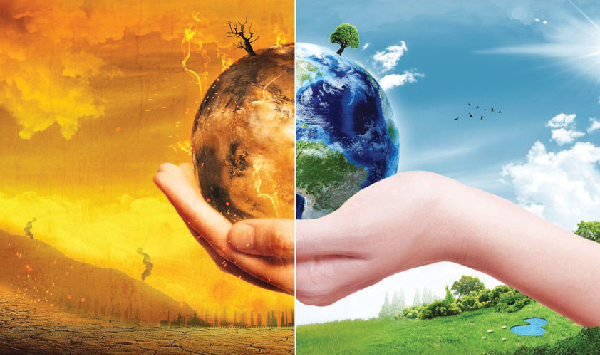
Peoples life in the 21st century is overwhelmed by the application of modern technology that aims to simplify living, get momentum in terms of time and labor, increase quality as well as solve problems. The application of technology and AI is also getting momentum in the prevention of the impacts of climate change.
But developing countries lag far behind in possessing advanced technologies including AI facilities. Furthermore, they are the primary victims of the global threat of climate change. Therefore, all forums and platforms need to give due attention to equipping Africa and other developing countries with the necessary technologies that can be of help for climate change prevention.
The recent launch of the UN-led AI Advisory Body advanced a growing global trend to harness machine learning to find solutions to common challenges, says a report by UNFCCC. AI is upping the data crunching game and a growing number of governments, businesses and civil society partners are working together to reap its many benefits.
That includes speeding up and scaling efforts to realize such global ambitions as the 2030 Agenda and its 17 Sustainable Development Goals (SDGs), which serve as the world’s blueprint to make the planet greener, cleaner and fairer.
Ahead of the latest UN Climate Change Conference (COP 28), which begins at the end of November in Dubai, UN News looks at how AI helps the world, from communities to corporations to law makers, tackle climate change:
AI-driven technologies offer previously unheard-of capabilities to process enormous volumes of data, extract insightful knowledge and improve predictive models, according to the UN’s World Meteorological Organization (WMO).
That means improved modelling and predicting climate change patterns that can help communities and authorities to draft effective adaptation and mitigation strategies.
Several UN agencies support vulnerable communities in Burundi, Chad and Sudan through an AI-driven project to investigate past environmental change around displacement hotspots and deliver future projections to inform adaptation measures and anticipatory action for integration in humanitarian programming.
On the ground, enhanced data can be a game-changer. For instance, the MyAnga app helps Kenyan pastoralists brace for drought. With data from global meteorological stations and satellites sent to their mobile phones, herders can plan ahead, better manage their livestock and save hours of scouting for green pastures. As extreme weather events unfold with more frequency and intensity, AI can help communities around the world to better brace for climate disasters.
AI-driven initiatives are targeting high-risk areas and feeding into local and national response plans. For areas susceptible to landslides, for example, mapping can help local authorities plan and implement sustainable development measures, reduce risks and ensure the safety of residents in vulnerable communities.
Related developments in AI and robotics were among the tools identified in a recent project led by WMO, UN Environment Programme (UNEP) and International Telecommunication Union (ITU). From enhancing accuracy in weather forecasts to reducing disaster risks, AI is already helping, according to WMO, which operates a disaster risk reduction programme and multi-hazard early warning system that serves countries, communities and humanitarian agencies.
Leveraging AI’s benefits is also part of the UN Secretary-General’s groundbreaking Early Warnings for All initiative. Launched earlier this year, the its action plan aims to ensure everyone on Earth is protected from hazardous weather, water or climate events through early warning systems by the end of 2027.
Ever wonder where urban air quality reports come from? Cities around the world already track pollution to alert the public in cases of dangerous levels.
Using AI, susceptibility maps can support local governments in making decisions to improve public health and urban resilience. In addition, AI can improve urban planning as well as traffic and waste management, making cities more sustainable and liveable.
AI can revolutionize the world’s approach to carbon neutrality and usher in an era of intelligent sustainability on a global scale at a time when the race is on to keep Earth from heating up to dangerous levels. As a critical catalyst in realizing global carbon neutrality goals, AI’s algorithms have a key role to play in minimizing environmental impact and maximizing efficiency.
In terms of realizing the global goal for affordable and clean energy for all by 2030 (SDG 7), AI can optimize grids and increase the efficiency of renewable sources. Predictive maintenance using AI can also reduce downtime in energy production. That can mean reducing the planet’s carbon footprint.
As an industry with a record of high emissions, fashion can benefit from AI-driven research and development to accelerate innovation. The $2.4 trillion-dollar global industry that employs approximately 300 million people across the value chain, many of whom are women, and the scale of the industry is only expected to grow over the coming years.
Given its size and global reach, unsustainable practices within the fashion sector have important impacts on social and environmental development indicators, and without major changes to production processes and consumption patterns in fashion, the social and environmental costs of the sector will continue to mount, according to the UN Alliance for Sustainable Fashion.
That’s where AI can step in. Machine learning can optimize supply chains to reduce waste, monitor resource consumption and promote sustainable manufacturing processes. AI can help to accelerate the energy transition by optimizing savings and improving efficiency across energy-intensive sectors.
Likewise with agriculture, another emissions-heavy sector. It accounts for 22 per cent of global greenhouse gas emissions, according to a UN climate assessment report, but AI-driven efforts can change that.
From corporations to small-scale farmers facing extreme weather events, water scarcity and land degradation, AI can help optimize their practices, reduce waste and minimize the environmental impact of food production. AI-driven smart grids can balance supply and demand, facilitating the integration of renewables into energy systems and reducing the reliance on fossil fuels.
This year’s Science and Innovation Forum, held in mid-October, focused on climate action. Hosted by the UN’s Food and Agriculture Organization (FAO), the week-long event showcased examples of technologies that aim to transform traditional practices into data-driven systems that protect people and the planet. Among them, AI and digital tools are pivotal in building climate-resilient agrifood systems that are more efficient, sustainable and adaptable to climate change challenges, according to the agency.
BY STAFF REPORTER
THE ETHIOPIAN HERALD WEDNESDAY 24 APRIL 2024





